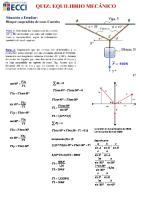Laplace Equation
EqWorld http://eqworld.ipmnet.ru Exact Solutions > Linear Partial Differential Equations > Second-Order Elliptic Parti
Views 93 Downloads 0 File size 68KB
Recommend stories
- Author / Uploaded
- api-3839714
Citation preview
EqWorld
http://eqworld.ipmnet.ru
Exact Solutions > Linear Partial Differential Equations > Second-Order Elliptic Partial Differential Equations > Laplace Equation
3.1. Laplace Equation ∆w = 0 The Laplace equation is often encountered in heat and mass transfer theory, fluid mechanics, elasticity, electrostatics, and other areas of mechanics and physics. The two-dimensional Laplace equation has the following form: ∂2w + ∂x2 µ ¶ 1 ∂ ∂w 1 r + 2 r ∂r ∂r r
∂2w = 0 in the Cartesian coordinate system, ∂y 2 ∂2w = 0 in the polar coordinate system, ∂ϕ2 p where x = r cos ϕ, y = r sin ϕ, and r = x2 + y 2 . 3.1-1. Particular solutions and methods for their construction. 1◦ . Particular solutions of the Laplace equation in the Cartesian coordinate system: w(x, y) = Ax + By + C, w(x, y) = A(x2 − y 2 ) + Bxy, w(x, y) = A(x3 − 3xy 2 ) + B(3x2 y − y 3 ), Ax + By w(x, y) = 2 + C, x + y2 w(x, y) = exp(±µx)(A cos µy + B sin µy), w(x, y) = (A cos µx + B sin µx) exp(±µy), w(x, y) = (A sinh µx + B cosh µx)(C cos µy + D sin µy), w(x, y) = (A cos µx + B sin µx)(C sinh µy + D cosh µy), where A, B, C, D, and µ are arbitrary constants. 2◦ . Particular solutions of the Laplace equation in the polar coordinate system: w(r) = A ln r + B, µ ¶ B m w(r, ϕ) = Ar + m (C cos mϕ + D sin mϕ), r where A, B, C, and D are arbitrary constants, and m = 1, 2, . . .. 3◦ . A fairly general method for constructing particular solutions involves the following. Let f (z) = u(x, y) + iv(x, y) be any analytic function of the complex variable z = x + iy (u and v are real functions of the real variables x and y; i2 = −1). Then the real and imaginary parts of f both satisfy the two-dimensional Laplace equation, ∆2 u = 0,
∆2 v = 0.
Thus, by specifying analytic functions f (z) and taking their real and imaginary parts, one obtains various solutions of the two-dimensional Laplace equation.
1
2
LAPLACE EQUATION
3.1-2. Domain: –∞ < x < ∞, 0 ≤ y < ∞. First boundary value problem. A half-plane is considered. A boundary condition is prescribed: w = f (x) at Solution:
1 w(x, y) = π
Z
∞
−∞
y = 0.
yf (ξ) dξ 1 = (x − ξ)2 + y 2 π
Z
π/2 −π/2
f (x + y tan θ) dθ.
3.1-3. Domain: 0 ≤ x ≤ a, 0 ≤ y ≤ b. First boundary value problem for the Laplace equation. A rectangle is considered. Boundary conditions are prescribed: w = f1 (y) at w = f3 (x) at
x = 0, y = 0,
w = f2 (y) at w = f4 (x) at
x = a, y = b.
Solution: ¸ µ ¶ X µ ¶ µ ¶ · ∞ nπ nπ nπ nπ (a − x) sin y + Bn sinh x sin y w(x, y) = An sinh b b b b n=1 n=1 µ ¶ · ¸ X µ ¶ µ ¶ ∞ ∞ X nπ nπ nπ nπ + Cn sin x sinh (b − y) + Dn sin x sinh y , a a a a ∞ X
n=1
n=1
where the coefficients An , Bn , Cn , and Dn are expressed as µ ¶ µ ¶ Z b Z b 2 nπξ 2 nπξ An = f1 (ξ) sin dξ, Bn = f2 (ξ) sin dξ, λn 0 b λn 0 b µ ¶ µ ¶ Z a Z a 2 nπξ 2 nπξ Cn = f3 (ξ) sin dξ, Dn = f4 (ξ) sin dξ, µn 0 a µn 0 a
µ
¶ nπa λn = b sinh , b µ ¶ nπb µn = a sinh . a
3.1-4. Domain: 0 ≤ r ≤ R. First boundary value problem for the Laplace equation. A circle is considered. A boundary condition is prescribed: w = f (ϕ) at
r = R.
Solution in the polar coordinates: Z 2π 1 R2 − r 2 w(r, ϕ) = f (ψ) 2 dψ. 2π 0 r − 2Rr cos(ϕ − ψ) + R2 This formula is conventionally referred to as the Poisson integral. 3.1-5. Domain: 0 ≤ r ≤ R. Second boundary value problem for the Laplace equation. A circle is considered. A boundary condition is prescribed: ∂r w = f (ϕ) at
r = R.
Solution in the polar coordinates: Z 2π r2 − 2Rr cos(ϕ − ψ) + R2 R f (ψ) ln dψ + C, w(r, ϕ) = 2π 0 R2 where C is an arbitrary constant; this formula is known as the Dini integral. Remark. The function f (ϕ) must satisfy the solvability condition
Z 2π 0
f (ϕ) dϕ = 0.
LAPLACE EQUATION
3
References Babich, V. M., Kapilevich, M. B., Mikhlin, S. G., et al., Linear Equations of Mathematical Physics [in Russian], Nauka, Moscow, 1964. Carslaw, H. S. and Jaeger, J. C., Conduction of Heat in Solids, Clarendon Press, Oxford, 1984. Polyanin, A. D., Handbook of Linear Partial Differential Equations for Engineers and Scientists , Chapman & Hall/CRC, 2002.
Laplace Equation c 2004 Andrei D. Polyanin Copyright °
http://eqworld.ipmnet.ru/en/solutions/lpde/lpde301.pdf









